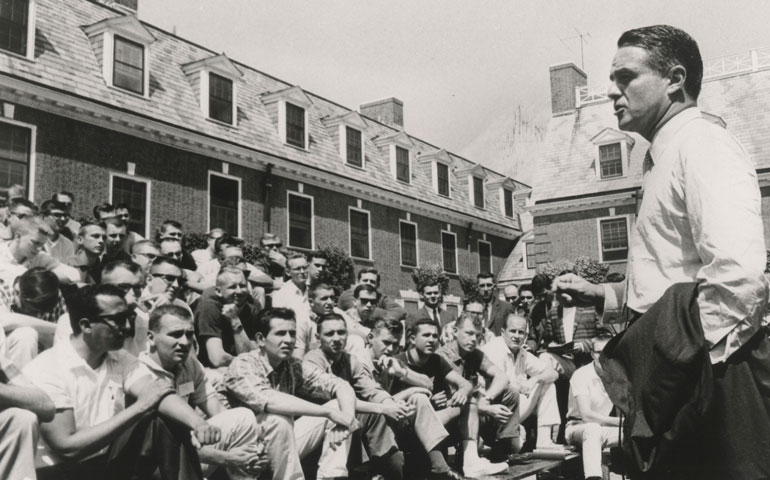
In June 1961, Sargent Shriver addresses an incoming group of Peace Corps volunteers before a six-week training program at Rutgers University in New Jersey. (Newscom/ZUMAPRESS/Keystone Pictures)
Hotels and religious houses in Rome were fully booked as throngs of pilgrims prepared to jam St. Peter's Square on Sunday to celebrate the dual canonization of two great popes.
In a move to unite left and right polarities in the church, Pope Francis chose two candidates who have been cultural icons in their lifetimes, acclaimed by the contemporary world as hallowed leaders. Catholics throughout the globe laid aside their differences on pressing church problems and joined together to applaud the heavenly entrance into the company of Christian saints two outstanding popes of modern times.
Henceforth, the faithful turn from praying for the sainthood causes of these two extraordinary people, to praying to them, asking for their help, naming churches and schools and even children after them. Most of all, Catholics will strive to emulate their virtuous example.
What gives added distinctiveness to the moment is the fact that many today remember both of these saints. In the case of John Paul II, the globe-trotting pontiff, millions shook his hand or waved to him as the popemobile navigated through their cities.
Although Pope John XXIII died 50 years ago during the black-and-white era of television, multitudes still living remember his smiling face as he blessed crowds from the papal armchair carried aloft by a dozen straining footmen. The life-giving church reform John XXIII inaugurated reverberates in Catholic life still and opened the church to the modern world.
As the canonizations of these two popes and the 2003 beatification of Mother Teresa of Calcutta illustrate, we are moving away from an age when Catholics come to know their saints only through stories, statues and stained glass windows. Instead, we are witnesses to their goodness firsthand.
But though we are getting closer to our saints, canonization is still weighed much too heavily toward religious celebrities. The ranks of candidates for sainthood remains stunningly thin when it comes to ordinary laypeople, Korean martyrs notwithstanding.
Earlier this month, a Spanish missionary to Brazil, the bishop of Quebec, and an Ursuline nun joined the ranks of saints. Since the new year opened, a New Jersey nun, a bishop from Spain, a priest from Italy and the queen consort of the two kingdoms of Sicily and Naples were beatified.
Where are the ordinary laity? Will obscurity continue to remain the destiny of a righteous layperson lacking a large religious community or diocese to plead his or her cause for sainthood?
Many of us can promptly think of deceased members of the faithful who lived very holy lives and make inspiring examples of the kind of people Francis has said the church is looking for -- "saints without cassocks and without veils."
Look no further, as far as this writer is concerned, than Sargent Shriver. He is a saint surely, or none of the rest of us has a chance. Together with his wife, Eunice, he energetically fought for the dignity of the disabled and he inspired thousands of young people to care about injustice and the poor, while raising a generous and loving family and participating fully in his faith. He led the War on Poverty and was the first director of the Peace Corps. The holiness and goodness he radiated transformed all who knew him. But even with his reputation and renown, Shriver is up against formidable challenges in gaining the official sainthood he merits.
It is true that much has changed about our understanding of sainthood since John XXIII convened the Second Vatican Council. We are now told that living holy and saintly lives is more within the grasp of the ordinary lay faithful than once thought. Sainthood in times past seemed reserved for virgins, martyrs dying horrendous deaths, or ascetical monks withdrawn from world. Yet, holiness is within the reach of all, we now learn.
During his trip to Brazil last year, Francis said: "We need saints to live in the world, to sanctify the world and to not be afraid of living in the world by their presence in it. We need saints that are open, sociable, normal, happy companions ... who know how to enjoy the best in this world without being callous or mundane."
So this week, as the joy of the canonization of both popes unfolds in the Eternal City, let us pray to them that they will send us an extra miracle and stack the deck in the future with more saints -- but this time, without so many cassocks and without so many veils. Maybe then we will better understand how God's saving love is mysteriously at work in all of our lives.
[Francis J. Butler writes on wealth, philanthropy and the Catholic church and is the founder of Drexel Philanthropic Advisors in Washington, D.C.]



